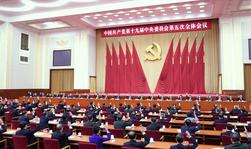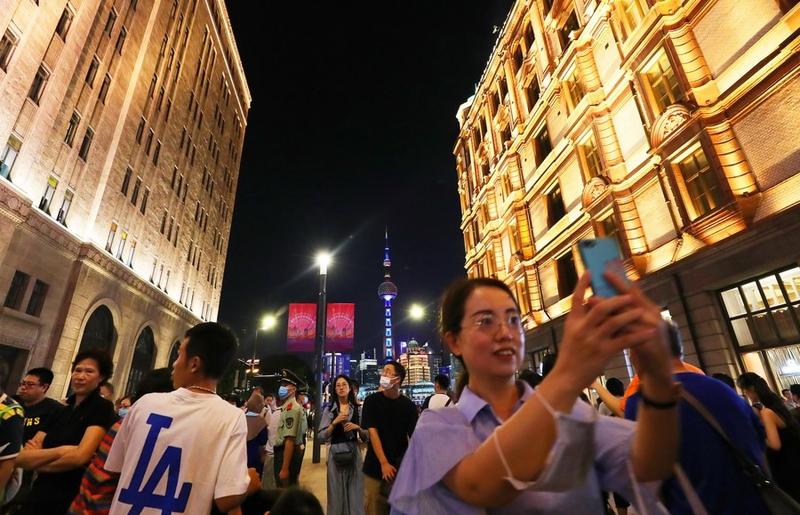 The Political Bureau of the Communist Party of China (CPC) Central Committee presides over the fifth plenary session of the 19th CPC Central Committee in Beijing, capital of China. (YIN BOGU/XINHUA
The Political Bureau of the Communist Party of China (CPC) Central Committee presides over the fifth plenary session of the 19th CPC Central Committee in Beijing, capital of China. (YIN BOGU/XINHUA
China's new five-year plan not only bodes well for the country, but will also help bring certainty to the world, according to analysts and academics.
"The ability of Chinese leadership to set realistic and achievable development agendas is one of the salient features of Chinese governance model," said Ahmed Quraishi, senior research fellow at Project Pakistan 21, an independent research organization in Islamabad.
"It's reassuring for both Chinese citizens, friendly neighbors, and international investors."
Guidelines for the 14th Five-Year Plan (2021-25) of economic and social development are included in a communique released on Oct 29 after the four-day Fifth Plenary Session of the 19th Communist Party of China Central Committee in Beijing.
READ MORE: A more open China to deliver more opportunities to anxious world
The focus rests on a holistic approach to high-quality growth, innovating in science on technology, uplifting of people’s livelihood, and building a new development pattern of "dual circulation" which stresses the domestic market as the mainstay to be complemented with international markets.
Mohammad Ahmed, assistant professor of Economics at Quaid-e-Azam University in Islamabad, said, "Chinese leadership’s motives are very clear. 14th Five-Year Plan in fact reflects a clear development roadmap of a country with nearly one-fifth of the world's total population, including 400 million middle-income earners.
It was China's stable development which successfully eliminated (absolute) poverty from the country. Also, it benefits the world.
Mohammad Ahmed, assistant professor of Economics at Quaid-e-Azam University in Islamabad
"It was China's stable development which successfully eliminated (absolute) poverty from the country. Also, it benefits the world."
Veronika S. Saraswati, China Unit Convener, Centre for Strategic and International Studies based in Jakarta, noted the plan highlights the growth pattern of "dual circulation".
"Being able to put a focus on developing the domestic market also means that China has realized its goal of developing a xiaokang society," said Saraswati. "Without achieving xiaokang, there will not be a strong domestic market." Xiaokang refers to a moderately prosperous society.
"'Dual circulation' is a great development strategy and I think it will be a successful one," said Saraswati, adding that the 14th Five-Year Plan has set an example for the rest of the world in terms of devising development and economic policies.
Noting China is a key player in the global value chain and an important economic partner for Southeast Asian countries, Saraswati said the economic recovery of China in the post-pandemic era will have a great impact on regional economies.
As "dual circulation" also emphasizes opening-up, Saraswati said she hopes to see more investment from China in Southeast Asian countries including Indonesia.
Academics noted the Five-Year Plan model has been instrumental in the progress of China since 1953, when Chinese great leadership unveiled the first five-year plan. Since then, the Party never looked back, rather, worked smartly and with enthusiasm to make China the world’s second biggest economy after the United States.
“China's five-year planning mechanism has been ensuring the country's gradual and concrete steps toward its goal of modernization, providing predictable opportunities to the world. The goals set in the 14th Five-Year Plan are doable given the track record of China's economic growth,” Mohammad Ahmed said.
 People visit the renovated East Nanjing Road Walkway in east China's Shanghai, Sept 12, 2020. (FANG ZHE/XINHUA)
People visit the renovated East Nanjing Road Walkway in east China's Shanghai, Sept 12, 2020. (FANG ZHE/XINHUA)
Highlighting China’s achievement during the 13th Five-Year Plan period from 2016 to 2020, Ahmed said the 13th plan has been about making China a “moderately prosperous society” and China “has accomplished the goal despite the pandemic of COVID-19".
"China is a 'moderately prosperous' country now. The Chinese leadership has achieved it by reducing its reliance on exports for economic growth and ensuring that growth is sustainable," he said. "Now that goals for the next five years have been set, no one can stop China becoming the world's biggest economy."
Data obtained from the World Bank showed that China’s gross domestic product (GDP) per capita has grown from the equivalent of US$89.5 in 1960 to US$10,262 in 2019.
The proportion of Chinese people living below the equivalent of US$1.90 per day fell from 66.3 percent in 1990 to 0.5 percent in 2016, according to the World Bank.
Socialist state or not, the Chinese consideration of helping its own people to benefit from the national success is what the US could not do over the last three decades.
Naveed Ahmed, academic specializing in geo-strategy and geo-politics
"The way China has brought its people out of poverty is an example for the world. The CPC deserves appreciation for this remarkable job," Ahsan Iqbal, former federal minister of planning of Pakistan, said.
It is believed that the Chinese leadership has been steadfast in approaching major issues concerning China's development from a long-term, strategic and systematic perspective.
Naveed Ahmed, GCC-based academic and commentator specializing in geo-strategy and geo-politics, also said Chinese leaders have done a great job by eliminating poverty from China.
"Socialist state or not, the Chinese consideration of helping its own people to benefit from the national success is what the US could not do over the last three decades," he said over the telephone.
Naveed noted the 14th Five-Year Plan will lead to greater innovation and ownership besides strengthening public confidence in the country. Moreover, the more China integrates the technological growth of Belt and Road Initiative partners, the better it would be for its own economic and geopolitical ambitions.
He was hoping that China goes beyond infrastructure development in nations involved in BRI and moves onto technological upscaling and capacity-building.
ALSO READ: Sino-US decoupling called unrealistic, harmful for all
Rajiv Biswas, Asia Pacific chief economist for global consultancy IHS Markit, said the development targets "put a strong focus on technology, environment and boosting domestic consumption".
Moreover, accelerating green and low-carbon development is also a key goal to meet UN climate change targets.
Quraishi in Islamabad added that a superpower like the United States is bound to have concerns in big power politics and to address them now is better than to grapple with them in a chaotic way into the future.
"The statements of the Chinese leadership on trade and political frictions with the United States are measured and positive. While exercising reciprocity in diplomatic back and forth, Chinese leaders have consistently maintained the desire to cooperate and work with America, dismissing any desire for strategic competition and conflict, and emphasizing a cooperative relationship," he said.
At the first press conference of the Central Committee of the CPC on Oct 30, Han Wenxiu, deputy head of the Office of the Central Commission for Financial and Economic Affairs, said complete decoupling between China and the US is unrealistic and does no good to two nations or the rest of the world.
Kaswar Klasra is a freelance journalist for China Daily.


